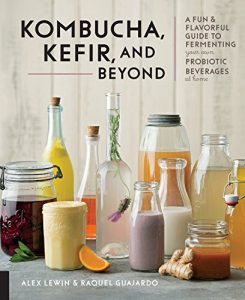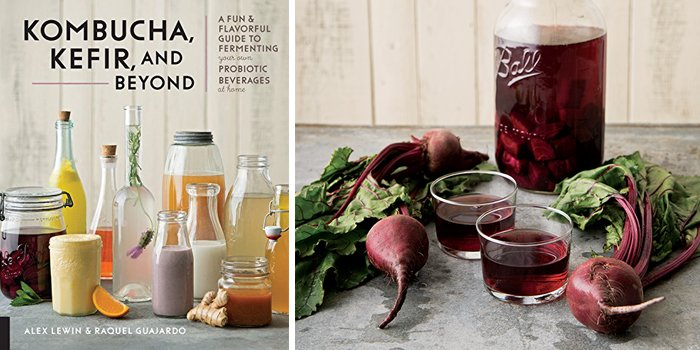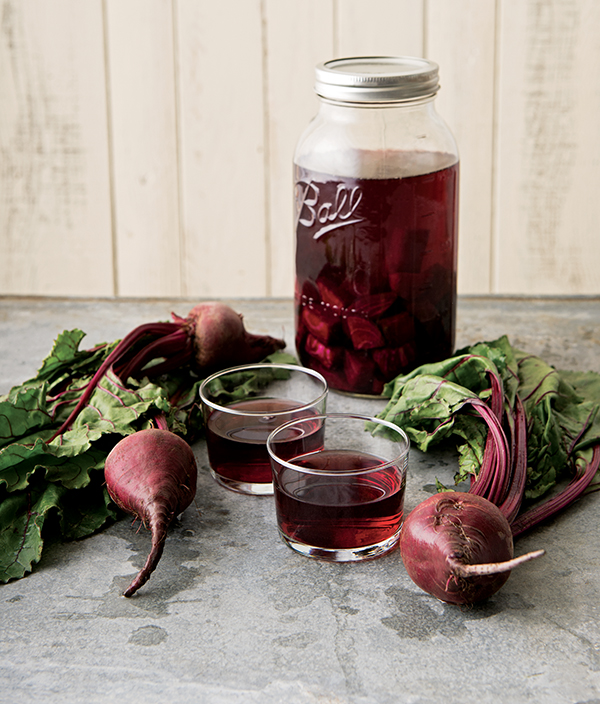 I like to keep up with health news, and I’ve been reading more and more about the importance of the body’s microbiome lately. The microbiome refers to the microorganisms in a particular environment, and in the body’s case it is the complex ecosystem of bacteria that live in the gut. Gut health is extremely important to health and immunity, so keeping the microbiome in balance is crucial. Fermented foods and drinks, such as sauerkraut and komucha, are essential for feeding the gut’s beneficial bacteria. They’re also great for improving digestion, strengthening the immune system, and helping the body assimilate nutrients. You could spend a small fortune stocking up on drinks like kombucha and kvass at the health food store, or you could make your own, thanks to the help of Kombucha, Kefir, and Beyond by Alex Lewin and Raquel Guajardo.
I like to keep up with health news, and I’ve been reading more and more about the importance of the body’s microbiome lately. The microbiome refers to the microorganisms in a particular environment, and in the body’s case it is the complex ecosystem of bacteria that live in the gut. Gut health is extremely important to health and immunity, so keeping the microbiome in balance is crucial. Fermented foods and drinks, such as sauerkraut and komucha, are essential for feeding the gut’s beneficial bacteria. They’re also great for improving digestion, strengthening the immune system, and helping the body assimilate nutrients. You could spend a small fortune stocking up on drinks like kombucha and kvass at the health food store, or you could make your own, thanks to the help of Kombucha, Kefir, and Beyond by Alex Lewin and Raquel Guajardo.
I have a fascination with making my DIY fermented foods and drinks, but I’ve yet to make any on my own. I read Kombucha, Kefir, and Beyond from cover to cover, and I now feel ready to take on the challenge. I’m going to start with Beet Kvass, which seems pretty easy to make.
In Kombucha, Kefir, and Beyond you’ll learn the importance of including fermented drinks in your diet along with their many health benefits. The history of fermentation is explained along with the science behind it. All of the basics to get you started are laid out, along with lists of equipment and troubleshooting tips. The safety of fermented drinks sometimes worries me, but that’s covered in the book, too.
The recipes in Kombucha, Kefir, and Beyond range from super-easy five minute drinks such as lassi and fermented lemonade, as well as drinks that take longer, like fruit soda. There are recipes for just about any type of fermented beverage you can thing of, including komucha, kefir, root beer, wine, kvass, switchel, vinegar, and mead. Not everything in the book is vegan, as some milk and yogurt recipes are included, but most of the recipes are plant-based.
The chapters in Kombucha, Kefir, and Beyond include:
- Why Ferment Your Drinks?
- Our Cultured History
- Fermentation, Science, and Health
- Before You Start
- Five-Minute Recipes
- Starters, Master Recipes, and General Principles
- Komucha and Jun
- Vegetable Drinks
- Sodas
- Beers, Grains, and Roots
- Wines, Ciders, and Fruits
- Mexican Pre-Hispanic Drinks
- Fermented Cocktails
Kombucha, Kefir, and Beyond is must have if you’re interested in fermenting your own drinks. Now excuse me while I head off to the kitchen to prepare that kvass!
- 2 or 3 beets, peeled if not organic
- 1 inch (2.5 cm) of fresh ginger, peeled if not organic (optional)
- 1 inch (2.5 cm) of sprig rosemary (optional)
- Approximately 11/2 quarts (1.5 L) filtered water
- 1 tablespoon (15 g) sea salt
- Coarsely chop the beets into 1⁄2- to 1-inch (1 to 2.5 cm) pieces. Cut the ginger (if using) into 1⁄4-inch (6 mm) chunks. Place the beets, ginger, and rosemary (if using) in a half gallon (2 L) Mason jar. Fill the jar halfway with filtered water. Add the salt, close the lid, and shake. Once the salt has dissolved, open the lid and fill with water to the shoulder of the jar, leaving 1 to 2 inches (2.5 to 5 cm) of space at the top. Close the lid. Write the date on a piece of masking tape and stick it to the outside of the jar.
- Let it sit for a few days to 1 week if your room is warm, or for 2 or 3 weeks if it’s cooler. The kvass will progress well if you keep the lid closed. Gently agitate once a day to ensure that mold does not form. You know it’s on its way when it starts getting foamy. Once you open the lid, though, it’s best to strain the kvass and refrigerate it because if you close it again and leave it at room temperature, molds can take hold.
- When you’re ready to put it into the fridge, pour it through a strainer to separate the beets (and other optional ingredients) from the liquid. The kvass is the liquid. Keep it covered in the refrigerator and drink it cold if you like.
- Keep the beet chunks in the refrigerator, too. They can be chopped up and thrown in salads or soups, blended and added to salad dressing, or put through a juicer. Or you can blend the beet chunks with some of the kvass as the base for a fermented beet gazpacho or borscht!
Recipe reprinted by permission from Kombucha, Kefir, and Beyond by Alex Lewin and Raquel Guajardo. c/o Fair Winds Press, an imprint of the Quarto Group

